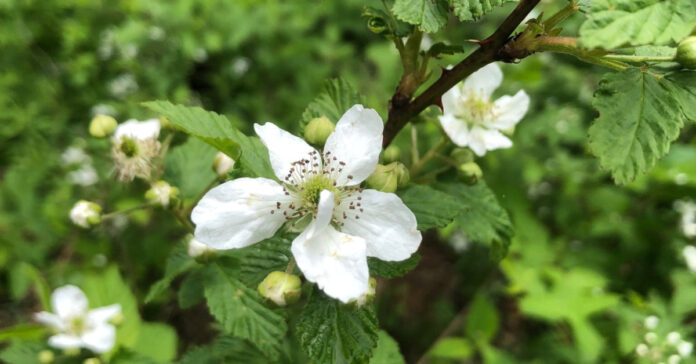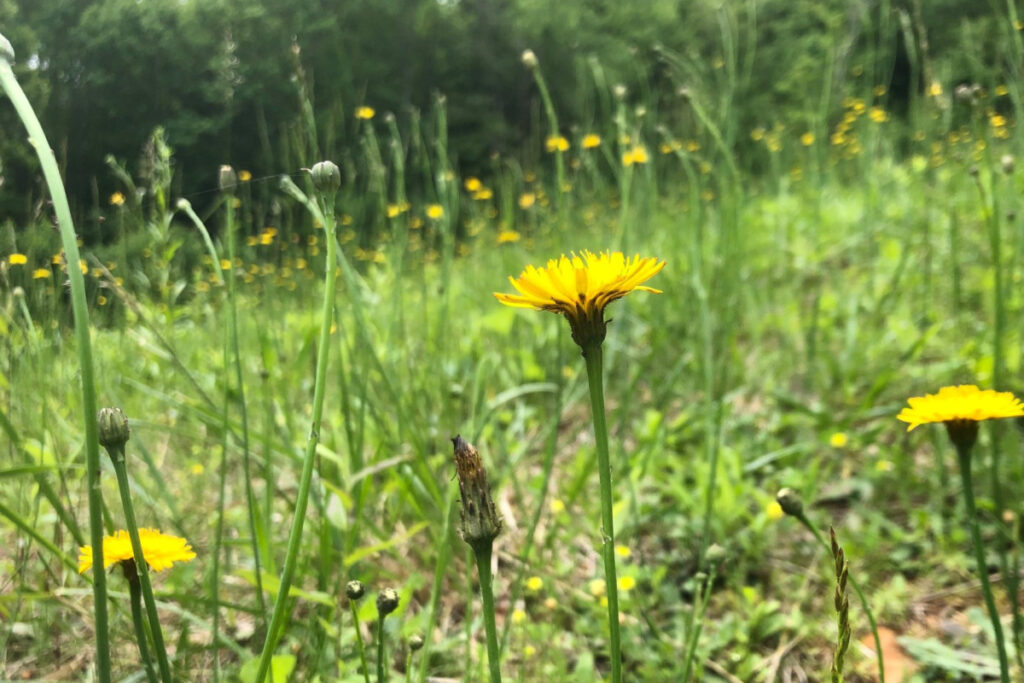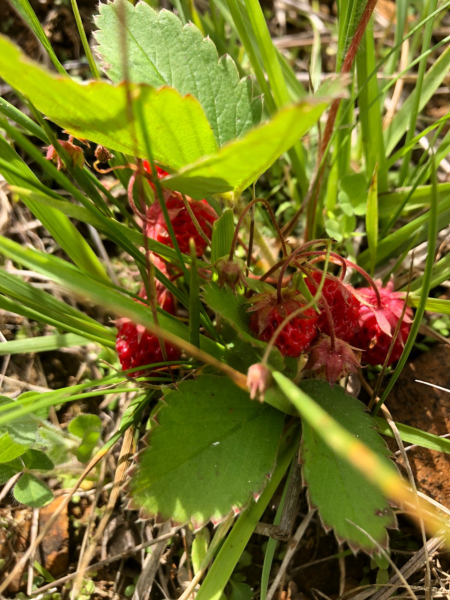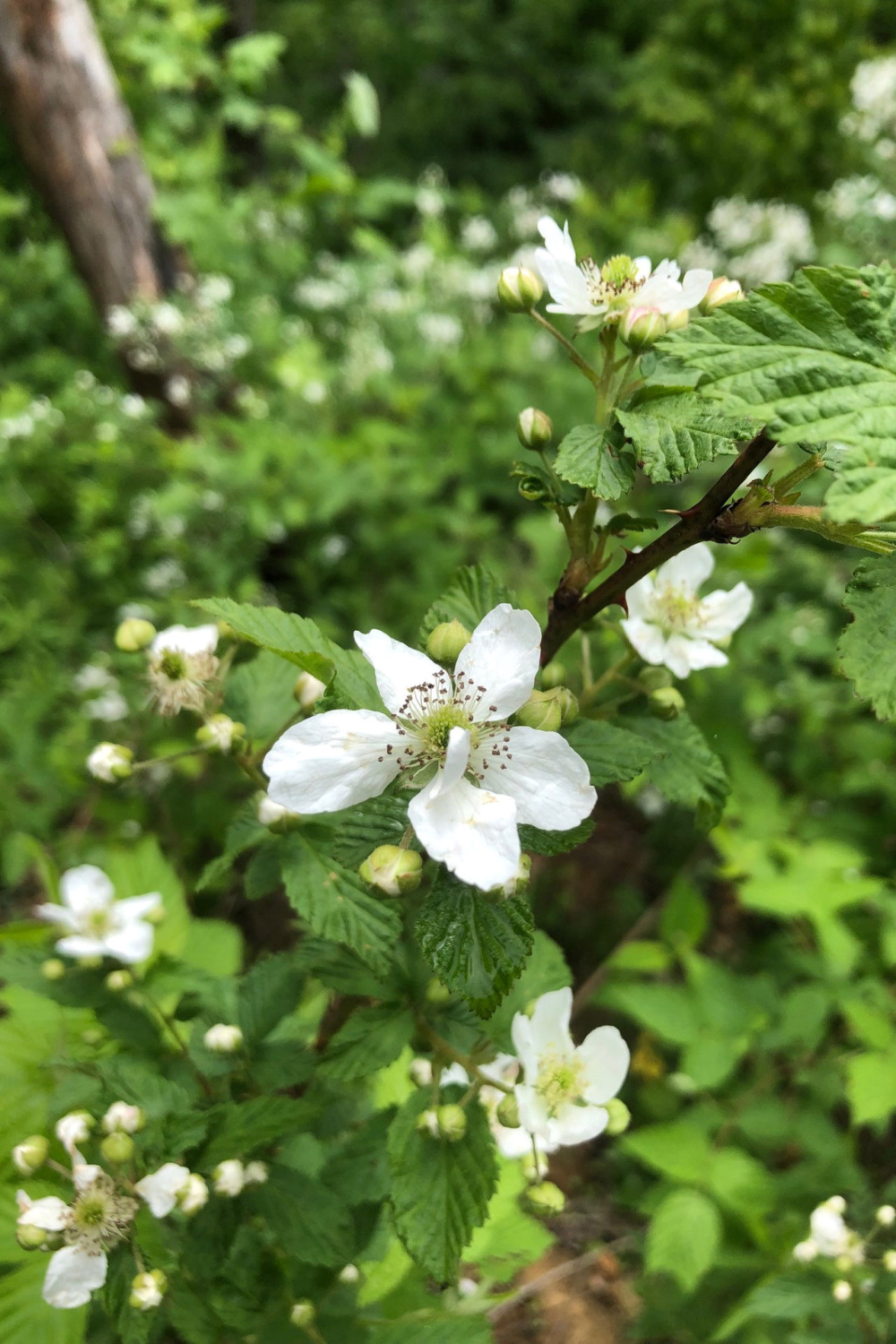
After several days of rain, the sun broke out and the blackberries finally bloomed. The black locust and tulip poplar bloomed a few days later. All three are excellent sources of nectar, which the bees harvest and turn into honey.
The bees are having a field day as they take advantage of this spring nectar flow. The foragers zoom in and out of their hives with laser beam intensity. They are so quick as they head off to the tree of their choice that I want to say “pew, pew, pew” as I watch.
They are filling the honey supers so quickly I ordered more. Because I have more large frames in stock than medium, I am also using at least one large hive body as a honey super.
I had hoped to have more equipment than needed, but the rapid growth exceeded my plans. Looks like I will spend more time in the wood shop in the near future.
Clover and Weeds
The mix of white and red seeds clover seeds I spread this winter has created a thick carpet of green in several locations and sporadic patches of clover in others. The white clover bloomed first while the pink blooms of the red clover came later. Honeybees like white clover, but their tongues are not long enough to reach the center of the larger pink clover blossoms. The bumble bees, butterflies, and other pollinators like them just fine, however. I saw one honey bee visiting a white clover blossom. I think of clover as a fallback source of bee food when their other choices are limited, so it surprised me to see her visiting the clover in the middle of the spring flow. Perhaps she was a scout bee.

My wife keeps telling me I need to mow the lawn (which is a misnomer, it’s a green weedy area and we never intended to be neat and tidy like a lawn). “But the bees like it!” I say as an excuse to hold off another day. Or another week. With the extensive array of wildflowers and weeds in our meadow and on our hillside, we should have multiple items in bloom until late July or early August. At that point, the numbers dwindle and the golden rod takes over.
We are having more rain now, and my fear is that it will dilute the nectar or wash away the pollen, affecting the amount of nectar available for harvest and therefore the amount of the honey produced.
Our First Harvest
Just over a week ago, we harvested several leaves from one of our Swiss chard plants. Since then, they’ve grown significantly, and we made a larger harvest. At their current rate of growth, I believe we could eat Swiss chard two or three times a week.
While we are pleased to have harvested something, it demonstrates the need for some serious food storage. Our first harvest of the year didn’t come until mid-May. I can see how easy it would be to starve to death over that long a winter. This is why you must have food storage and why you must have a large garden after the SHTF so you can preserve as much additional food as possible. It’s quite clear that our small raised beds will never be enough to feed us. We can hope they are enough to keep us from getting scurvy and will provide us with the experience we need to scale up and grow more post-SHTF.

Our potatoes and cabbage continue to do well, but it will be weeks before we can harvest these. Both are good for survival gardening, however, and can be stored into the winter.
I noted that the wild strawberries, tiny ground-hugging plants with berries about as big around as a dime, are ripening. We picked several, but they require a few more days of sunshine to ripen fully. They grow in multiple parts of our landscape and when ripe, we can gather a sweet handful in moments. My wife adds them to her oatmeal and salads.
More Vegetables
Now that our last frost date is past, we planted some warm-weather vegetables: cucumbers, yellow squash, zucchini, kale, several herbs, and three kinds of sunflowers. Some of these seeds are from 2018, so it will be a test to see if they germinate. I put two of these in each hole, hoping to improve my odds of having one sprout. If we get two plants, I’ll pinch off the weaker one in each hole.
I planted the sunflowers guerilla style, sticking my trowel in wherever there seemed to be a place that wasn’t already overgrown with weeds. No compost, no fertilizer, no soil amendments of any kind. Just seeds an inch into bare, raw ground. If most of them sprout, grow, and bloom, we will have sunflowers along both sides of the driveway, up and down the hill, inside the garden fence and outside it, and near the septic tank. When I ran out of the commercial seeds from the packets I purchased last year, I planted the black oil sunflower seeds from the 50-pound bag I use to feed the chickens. I will laugh if these outperform the others.
My plan is for the bees to benefit from them sunflower blossoms in early August and for us to harvest the heads to feed the chickens that fall and winter. I understand you can toss a dried seed head into their run or hang it up and let them peck at it for some chicken fun.
Like much of our gardening this year, the sunflowers are a trial run. If they do well, I will know they are a potential food source for us and the chickens. If they fail, then I will know they need a more carefully prepared bed and some nurturing rather than being cast forth in unprepared raw soil.
Free Ranging the Chickens
On days when the weather is good, I am allowing the chickens some supervised free-range time. Between this and the warm weather, they are eating only about 60 percent of the commercial feed they consumed all winter. As feed prices rise, that’s a nice saving.
Last year, we had a rooster that headed off to the woods and spent the night in the trees. He came home the next morning, but I wanted to avoid this since he may lead some of our laying hens away with him. The trick, I have found, is to free range the chickens in the morning and withhold their scratch until I want them to return to their run. Then I shake the scratch and call “here chickee-chickee,” and they come running. Each time, a couple of them are not smart enough to make it back through the gate to the inside their run. They look on glumly through the fence as the other birds suck up the scratch like miniature shop vacs. I have to work my way behind these wayward birds and herd them back into their run.
When time or weather does not allow them to free range, I cut a big bucket full of weedy greens, the seed heads from various grasses, and handfuls of clover and dump them into the run. This doesn’t give the chickens as many bugs to eat as free ranging does, but it’s a good compromise. It amazes me how the greenery just exploded this spring. I believe we are several weeks ahead of last year.
More Firewood
I also stacked an additional cord of firewood this past week. I plan to buy another load in June.
These are busy times and my “to do” list still has 19 items on it. That’s a little frightening when you consider how much busier we would be in a post-SHTF situation with no electric range or refrigeration, no gas-powered tools, and minimal lighting. I’ve written about being thrown back to the 1880s, and I have no desire to live at that technological level.
If the decay I wrote about yesterday continues and our disaster is a societal or financial collapse rather than a calamity that comes with a big bang and changes everything in one fell swoop, we may escape the 1880s. Even six hours of electrical power on a regular basis would contribute to a better standard of living and access to some modern conveniences.
Think how bad things would have to become that we think of six hours of electricity as a godsend. Ugh.








